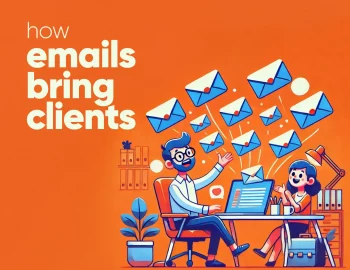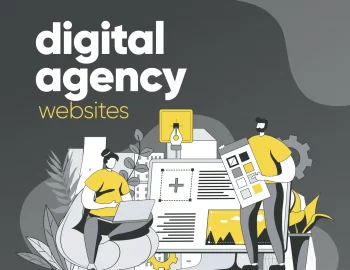A collection of visual content marketing examples that show how real brands use visuals to grab attention and keep people interested.
When someone says “content marketing”, most people picture blog posts, SEO keywords, and maybe a white paper that hasn’t seen daylight since 2014. But if you want people actually to notice your stuff, it needs to look good. That’s where visual content marketing comes in.
It’s everything from bold hero images to punchy infographics, awesome videos, dank memes, and those polls you low-key vote in while pretending to work. Visual content grabs attention, breaks up walls of text, and sticks in people’s memory way better than another paragraph explaining why your service is “cutting-edge”. (Spoiler: they’ve heard that one before.)
Well, what does good visual content look like? I went on a little internet treasure hunt and rounded up visual content marketing examples of each major type, real work from real brands who are actually doing it right. So, no matter if you work solo, build client websites, or try to keep your agency’s feed from looking like a PowerPoint from 2006, this collection’s full of ideas worth stealing (nicely).
Images and Illustrations
These two sit at the heart of visual content marketing. They break up long blocks of text, guide the reader’s focus, and help communicate ideas faster than a paragraph ever could. You’ll often see brands use photos, icons, hand-drawn sketches, and custom graphics to shape how people feel about their content and their product.
The real value here is clarity, of course. A simple diagram can explain a tricky concept without needing a wall of words, while a playful illustration can make a boring topic feel kind of fun. It’s all about helping people get it faster, while keeping things easy on the eyes.
This type of visual works well in blog posts, infographics, landing pages, and even pitch decks because it’s flexible, quick to digest, and (when done well) super shareable.
Let’s take a look at some websites using images and illustrations in smart, creative ways.
View this post on Instagram
View this post on Instagram
View this post on Instagram
View this post on Instagram
View this post on Instagram
View this post on Instagram
Videos
Videos are perfect for people who’d rather watch than read. They let brands say a lot in a short amount of time without expecting the audience to scroll through endless paragraphs. You can show how a product works, explain a service, or introduce your team with real faces and voices, all in a format that feels natural to consume.
And videos’s not just a nice-to-have. It’s a full strategy. According to Wyzowl, 89% of businesses use video as a marketing tool and that number keeps climbing. Videos may include everything from quick social clips to longer tutorials,and serve all kinds of purposes like product demos, customer stories, live Q&As, and even repackaged blog posts.
The best part is that people actually pay attention to videos. That means higher engagement, better retention, and more chances to build trust.
Let’s check out some examples of how brands are using video content to connect, explain, and convert.
View this post on Instagram
View this post on Instagram
View this post on Instagram
View this post on Instagram
View this post on Instagram
View this post on Instagram
View this post on Instagram
View this post on Instagram
View this post on Instagram
Slideshows
Slideshows give you a way to tell a visual story one step at a time. Instead of dropping everything on the page at once, you can walk viewers through a message with simple, focused slides. This format works especially well for social platforms like LinkedIn or Instagram, where people can swipe through at their own pace.
What makes slideshows handy is their pacing. They help you avoid information overload while keeping things visually appealing. Each slide can focus on one point, and they’re a great way to repurpose existing content from blog posts, reports, or webinars.
Think of slideshows as mini-presentations that don’t require a stage. They’re casual, easy to follow, and pretty engaging when done right.
Now let’s look at how some brands use slideshows to make their content scroll-stopping.
View this post on Instagram
View this post on Instagram
View this post on Instagram
View this post on Instagram
View this post on Instagram
View this post on Instagram
View this post on Instagram
Infographics
Not everyone wants to dig through a full report or spreadsheet, but most people are happy to scan a good-looking infographic. This format turns raw data, stats, timelines, and even processes into clean, eye-catching visuals that are way easier to absorb.
They’re also super versatile. You’ll spot infographics inside blog posts, tucked into case studies, or shared as standalone assets on social platforms. And they’re great for traffic too—people tend to share them more than regular text posts, especially when the visuals are sharp and the takeaways are clear.
Most businesses use infographics to visualize research results, product comparisons, or simplify tricky topics. They’re especially useful for marketing to people who like data, but don’t want to spend all day reading it.
Here are some infographics that get the point across fast and in style.
View this post on Instagram
View this post on Instagram
View this post on Instagram
View this post on Instagram
If 5500 cups are drunk per second how many NESCAFÉ were enjoyed around the world since you started reading this 😜 pic.twitter.com/7CSVvOlpxl
— NESCAFÉ Coffee (@NESCAFE) September 12, 2016
Photography
Next, you have photography that gives content a real-world feel. When used well, photos can add warmth, personality, and a much-needed human touch. You can use them to spotlight your team, highlight products, or bring some everyday context to your message.
You don’t need a full production crew either. Plenty of brands lean on high-quality stock photos when custom shots aren’t in the cards. The trick is picking images that feel natural—no stiff handshakes or forced smiles. Go for visuals that actually feel connected to your story.
Photographs fit in just about anywhere: blog posts, ads, social media, email campaigns, product pages, you name it. They help break up text, draw attention, and set a tone without needing a single word.
Let’s see how brands use photography to keep their content grounded and approachable.
View this post on Instagram
View this post on Instagram
View this post on Instagram
View this post on Instagram
View this post on Instagram
Memes and Puns
Memes are fast, funny, and just the right amount of weird. They’re the internet’s way of sharing tiny moments of humor and for brands, they offer a chance to show a little personality. When done with care, memes can boost relatability and make people feel like you’re part of the conversation, not just talking at them.
The key here is timing and tone. Not every meme fits every brand, and that’s okay. Some might carry hidden references you don’t want to be linked with, so it helps to do a quick background check before posting. Sites like Know Your Meme make that part easier.
And while the jokes matter, the goal is still connection. If your content makes someone smile or nod in recognition, they’re more likely to engage and maybe even stick around.
Here are a few examples of brands using memes and puns to keep things light, clever, and on-point.
View this post on Instagram
View this post on Instagram
Questions and Polls
Asking questions might sound simple, but it’s one of the easiest ways to get people talking. Questions and polls give your audience a reason to pause, think, and chime in. They also show that you’re listening, not just broadcasting.
This type of content works especially well on platforms like Instagram Stories, LinkedIn, or X, where interaction feels natural. You can keep it light (“Which logo do you like more?”) or go deeper with thoughtful prompts about your industry. Either way, the goal is to invite people in.
Add a little visual flair, maybe an illustration or a clean graphic and you’ll make your post stand out even more. The response you get can help shape future content, uncover customer pain points, or just remind people that there’s a real human behind the brand.
Here are a few visual content marketing examples where simple questions and polls turned into solid engagement.
View this post on Instagram
View this post on Instagram
Technology is ever envolving, are u keeping up with it?
Take a sec & give ur answer. #PollOftheWeek pic.twitter.com/lqX3mKgwCu— Encodle Technologies (@encodle) March 9, 2016
Girls just want to have coffee. Anytime, anywhere 😉 #getinspired pic.twitter.com/oI0udXize8
— NESCAFÉ Coffee (@NESCAFE) August 15, 2016
View this post on Instagram
And there you have it!
Visual content marketing doesn’t have to be over-the-top or wildly complex. All it needs to do is connect. Hopefully, these examples gave you a few ideas to include in your next brainstorming session.





